I planted Leucojum aestivum into the banks behind the house ten years ago now. I had a vision of them below the crab apples, following on neatly after the Crocus tomassinianus, but being there for the duration of spring. First with the sky-blue spangle of Anemone blanda and then, as the meadow turf lengthened and the crabs came into flower, with Pheasant’s Eye Narcissus and the creaminess of tapering camassia.
Having a vision in your mind’s eye is important when planning a garden and I always have one at the beginning even though the reality may take many years to come to fruition. The years needed for the Anemone blanda to naturalise and for the turf under the crab apples to be fine enough in their young shadows to introduce a scarlet slash of Tulipa sprengeri. But things do not always come to pass, despite best judgement. Gardens are places where a myriad of unseen elements have to be negotiated.
The getting to know, what does and what doesn’t do, is a conversation of sorts, a silent one based on observation, response and adjustment. Sometimes you have to let go of an idea and I feel I have waited long enough for this particular vision to materialise. The leucojum appear and flower, but never flourish as I had imagined they might with lush clumps of strappy foliage and arching droplets of flower. Though our ground is heavy and retentive, the bank is drier than I had thought with a native hedge at the top drawing upon resources and a steep slope that drains freely. The primroses love it, proving there is spring moisture, and the winter snowdrops thrive here too as they like to dry out in the summer, but the leucojum simply do not thrive and I can feel it.
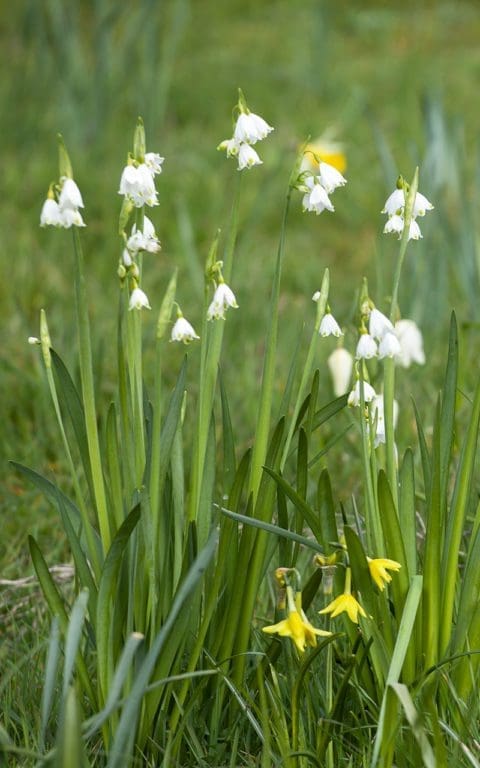
So it is time to change tack, a response that very often yields the results you had planned for. A plant may simply not like the place you have chosen for it and moving it somewhere that it may prefer is often all that is required.
Though they are adaptable garden plants, I want to open up the best possible opportunity now that I have decided to try them in a new position. Read about the native habitat of Leucojum aestivum in Europe and one particular image of them growing in a Croatian wet meadow amongst crack willows stays very much in mind. In ground that lies damp and may well flood in winter, the leucojum find a niche in a competitive environment where they have the moisture they need to thrive in company and to naturalise.
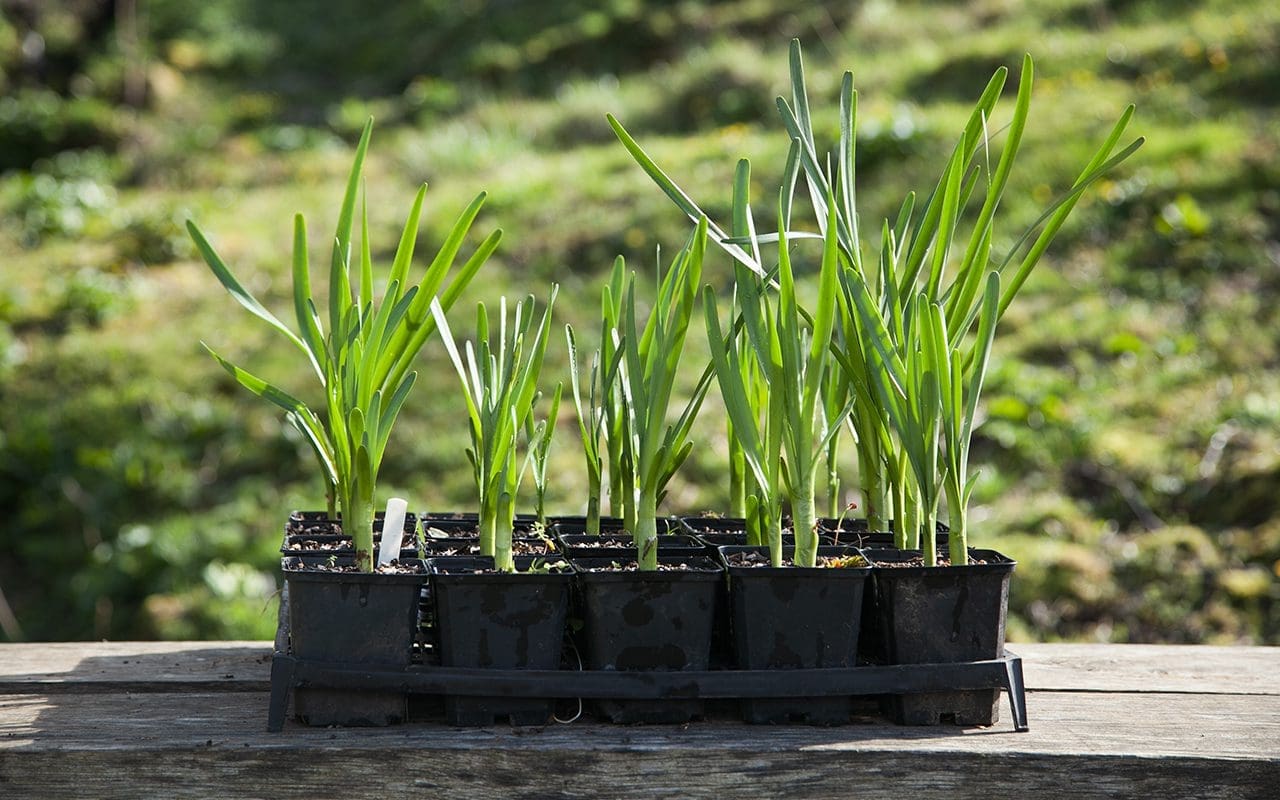
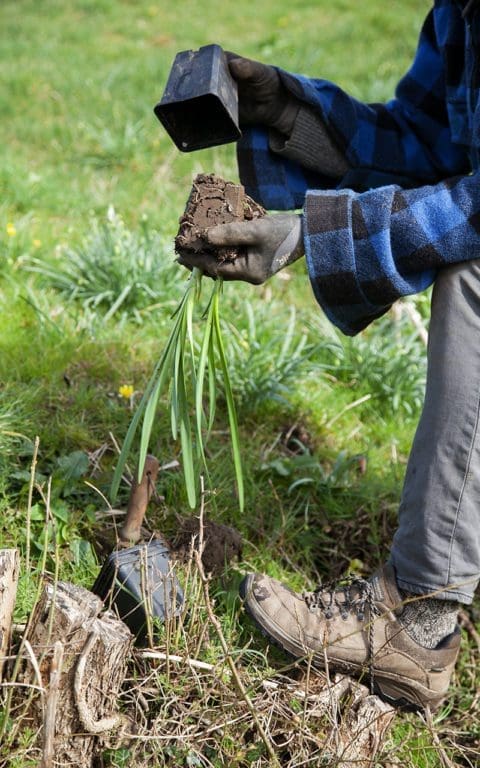
Leucojum aestivum ‘Gravetye Giant’, is a strong-growing form selected by the naturalist William Robinson and named after his home at Gravetye Manor. The bulbs were potted last autumn so that I could introduce them after the ditch has been trimmed in early winter. I have planted two new colonies. One in the garden in a non-competitive environment, in open ground amongst the sanguisorbas where they will have the early window of April to flower and feed before the burnets fill out and take the position. The other in the wet banks that slope steeply into the ditch.
The damp ground in the ditch near our own crack willow is where I am hoping to naturalise snakeshead fritillaries and winter aconites. The bulb layer will come ahead of the early summer rush of damp-loving natives that thrive here. Meadowsweet, giant horsetails and wild angelicas take this ground, but I’ve been working in a number of bulky perennials that can tough it out in what become rough growing conditions come high summer, amongst them marsh spurge (Euphorbia palustris) and moist woodlander, Aruncus dioicus. Plants that like wet feet and can get their head and shoulders above the crowd as the leucojum fade and retreat into dormancy. My hope is that the summer snowflakes will find their niche here. A place where they can thrive rather than simply do and somewhere that will help me fulfil a vision that is still very much up and running, but has simply moved locations.
Words: Dan Pearson | Photographs: Huw Morgan
Published 12 March 2022
The Tenby daffodils are flaring on the banks that fall steeply into the ditch. Backlit by morning sun they are the purest of yellows, brilliant and bright and so very full of life. The tilted buds are already visible breaking their sheaths as the snowdrops dim and the primroses take over and begin their moment. The narcissus join them then, not to overshadow as you might think, but in a partnership of yellows, the colour of spring and new life.
Now considered a subspecies of our native daffodil, N. pseudonarcissus subsp. obvallaris is found locally near Tenby in Dyfed, South Wales, where they have a small range of natural distribution. Their cousin, N. pseudonarcissus, is variable, with a soft yellow trumpet and palest yellow petals, so a group registers quite differently and they have a softness that sits easily. Not so the Tenby daffodil which is brazen and to the point, being bright chrome yellow throughout. Though this might not be easy in a larger daffodil, the Tenby is no more than a foot tall and everything is perfectly proportioned and neat. Thus they weather the March storms and stand like a person with innate confidence that is happy in their own skin.
The crease in the land that we call the Ditch is far more than that. It is the divide between the ground that we garden and the rounded rise of the Tump that we look out upon and forms our backdrop to the east. The spring-fed rivulet that runs quickly down it is constant and gurgling, even in summer. The silvery slip of water was revealed when we cleared the brambles 10 years ago and fenced it on both sides so that this distinct habitat could become an environment of its own. We have been building upon the nature of this place ever since. Splitting the primroses that sit happy in the heavy, wet ground and stepping plants through it that are either closely related to the wild plants that thrive there or feel right and can cope with the competition.
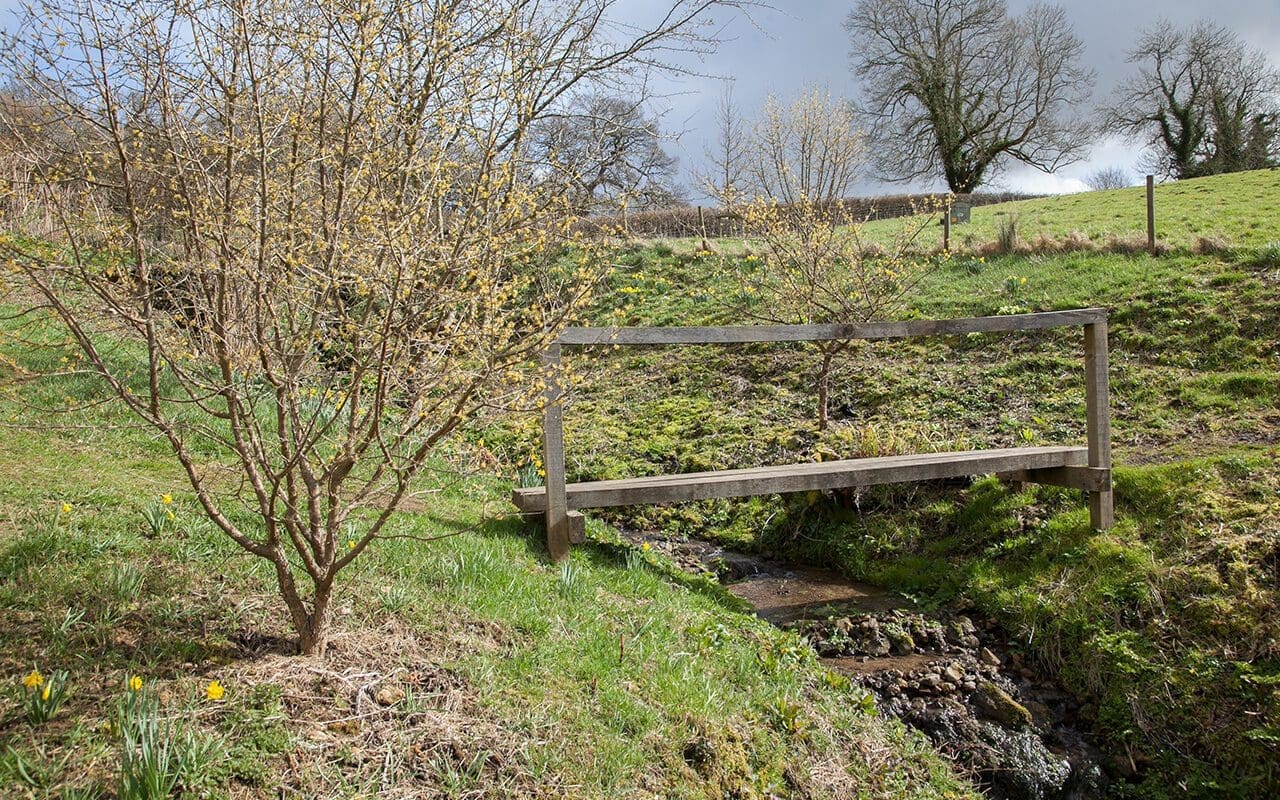
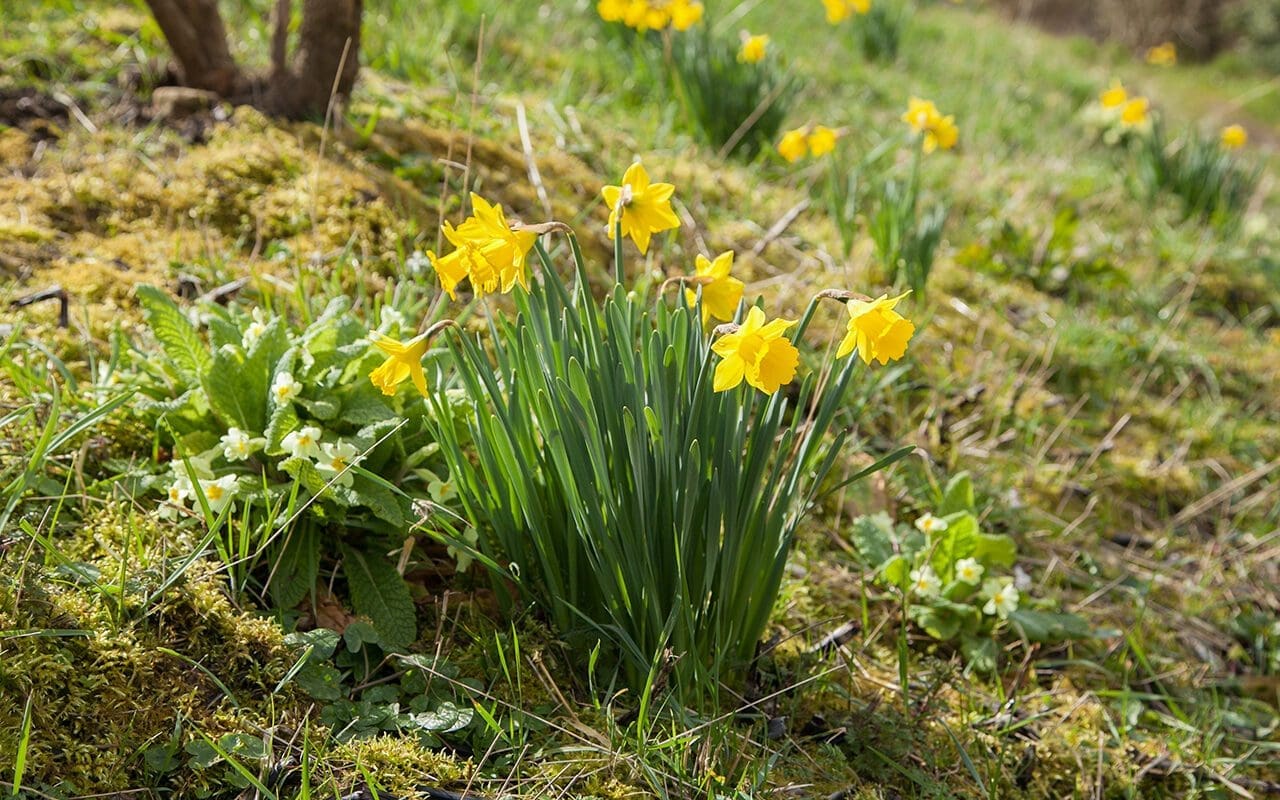
The Ditch is a place that we garden lightly and the plan is to one day have it naturalised with bulbs that like the conditions here. Snowdrops and aconites to start the year and snakeshead fritillaries and camassia to follow. The Narcissus obvallaris are grouped loosely around a staggering of Cornus mas, which start to bloom when you can feel the winter easing.
So far the Tenbys have not started to seed, but I hope that our man-made imprint can be softened with seedlings that find where they want to be. This has begun already with the straight Narcissus pseudonarcissus, which I’ve been planting lower down the slopes and, in an echo of the ones we found higher up the valley, growing on little tumps that run alongside the stream where the hazel grows. They sit there with the young Dog’s Mercury as a marker of this ancient woodland and looking down on all they survey. The way they grow in the wild is a good measure for where they want to be when you find them their home. Cool, but not in the wet hollows and with a little shadow later to ease up the competition of the more thuggish grasses.
Having been stung a couple of times with narcissus orders that were incorrectly supplied, I started three years ago by potting up a hundred bulbs, two to a pot, as I needed to know that we were putting the real thing into this wild place. It was the year that Huw’s mother passed away and, as his family are from Swansea, it felt fitting to be planting them out just a fortnight after she died. The Tenbys start to bloom around St. David’s Day and, when the first yellow shows, we add another round of plants potted up the previous autumn. Midori and Shintaro from Tokachi Millennium Forest took part one year when they were here to stay on a ‘gardening holiday’ from snowbound Hokkaido, and it has now become something of a tradition to plant a number round about now to find the places in the ditch where we feel the light needs capturing.
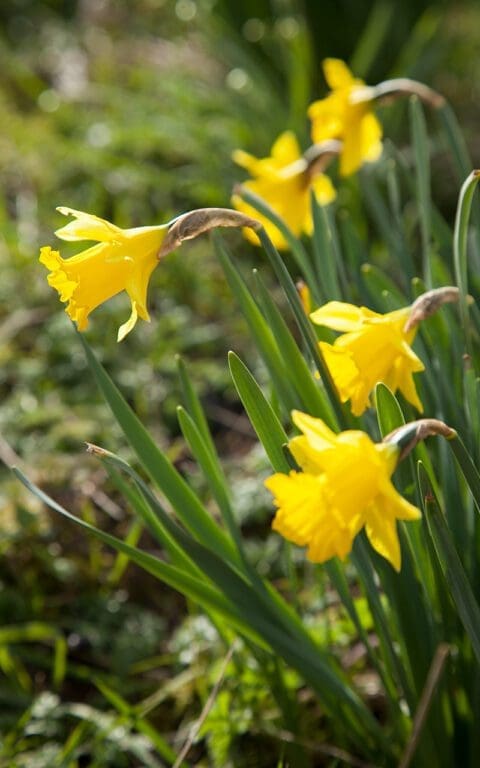
Words: Dan Pearson | Photographs: Huw Morgan
Published 13 March 2021
Against the odds, the delicate Crocus tommasinianus ‘Albus’ spear the turf on the bank in front of the house. When you first become aware of their presence earlier in the month it is easy to mistake their pale tapers for the light reflecting off blades of grass, but suddenly and all at once they are free. Standing tall enough above the sward to shiver in the slightest of breezes and opening wide in a sunny interlude to reveal orange stamens, yellowed throats and nectar for the early bees.
I first grew Crocus tommasinianus in the Peckham garden and learned to love it there for being the superior cousin to the ‘Dutch’ Crocus vernus which stud front lawns in spring like spilled tins of Quality Street. I did not know it then, but I had been supplied with the true species, which has the palest silvery-lilac reverse to the petals with the colour held within. I have since repeated my orders, again and again and from different places, only to find I have planted a thousand ‘Ruby Giant’ here or two thousand ‘Whitewell Purple’ there. These darker selections are often mis-supplied and sit less lightly for their weight of saturated colour.
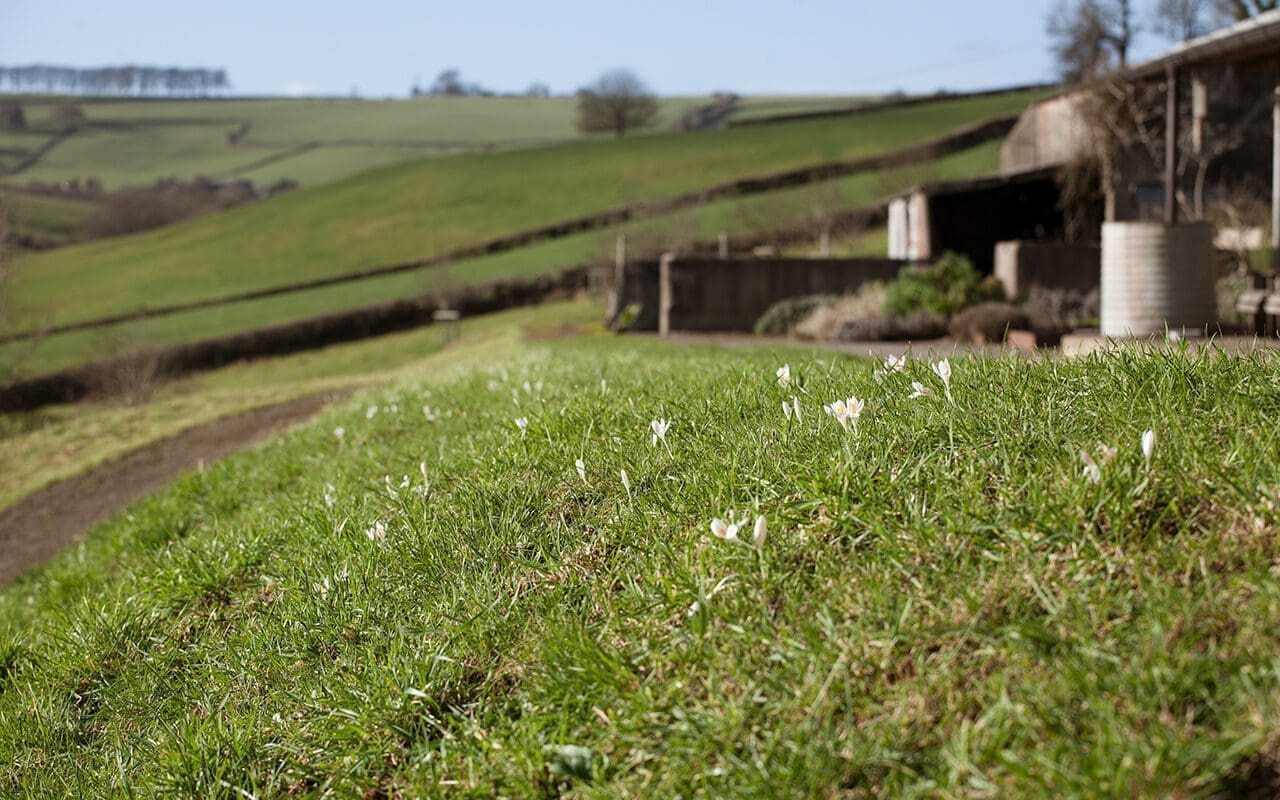
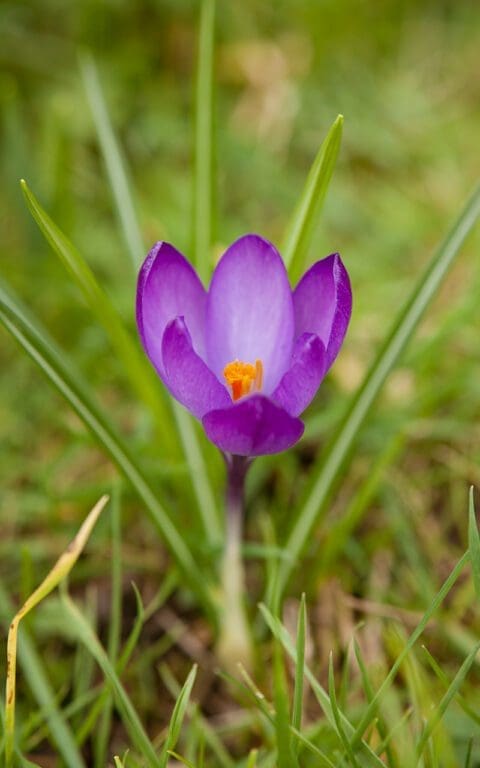
Just up the lane and making the point that they are happy there, the true form has taken over our neighbours’ garden. The sisters that live there are natural gardeners and have been tending theirs now for decades. Without competition the crocus have seeded freely, to the point of flooding the open ground of their borders, seeding into the crowns of all the plants and seizing every niche between paving stones. The garden is free and joyous and Josie and Rachel never see their occupancy as a problem.
We have struck up a friendship and Rachel has generously allowed me to dig them in-the-green immediately after flowering so that I do not have to depend upon the vagaries of the bulb suppliers. I am going to keep them out of the beds here, however, as I want to work in the garden just as they come into leaf when I’m preparing the garden for spring. The sunny banks at the back of the house are where I am hoping they will naturalise. The free-draining slope there is ideal, because they like dry ground when they are dormant and the sunshine ensures that their flowers, which are light sensitive, open to reveal their interiors. When they do, you feel your heart lift and the long dark winter retreat.
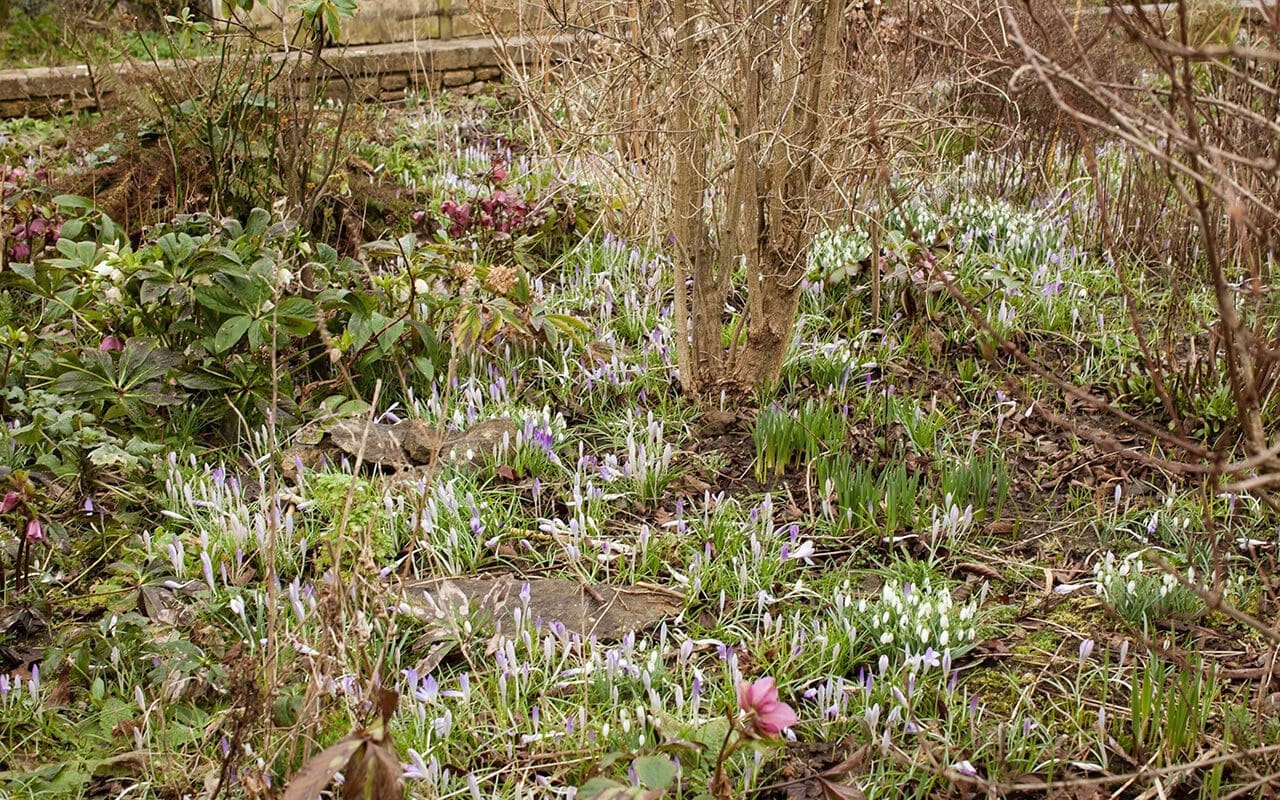
I can already see from their behaviour in the grass under the young crab apples that they will not seed as freely as they have in the open ground of Josie and Rachel’s garden. Though happy in grass, the lushness of our meadows is probably too much for the young seedlings to take a hold. I hope in time, and once the grass thins as the crab apples assert themselves, that they will take to a lighter sward and begin to make the place their own. This is worth waiting for and every year I am adding a few more with Narcissus jonquilla and Anemone blanda to follow after their early blaze is over.
Shipton Bulbs stock a number of special selections that are subtler than the named varieties above. The rosy Crocus tommasinianus ‘Roseus’ (main image) and C. t. ‘Pictus’ which looks as though the tips of the petals have been dipped in ink. The white form, Crocus tommasinianus ‘Albus’, is very choice and, as they do not come as cheap, I ordered a couple of handfuls and gave them their own place on on the bank at the front of the house in the hope that they will not cross with the others at the back. The position here is exposed to our winds that whip across the open ground, but they stand bravely and mark the shift in the season with the snowdrops and the promise of what lies just around the corner.
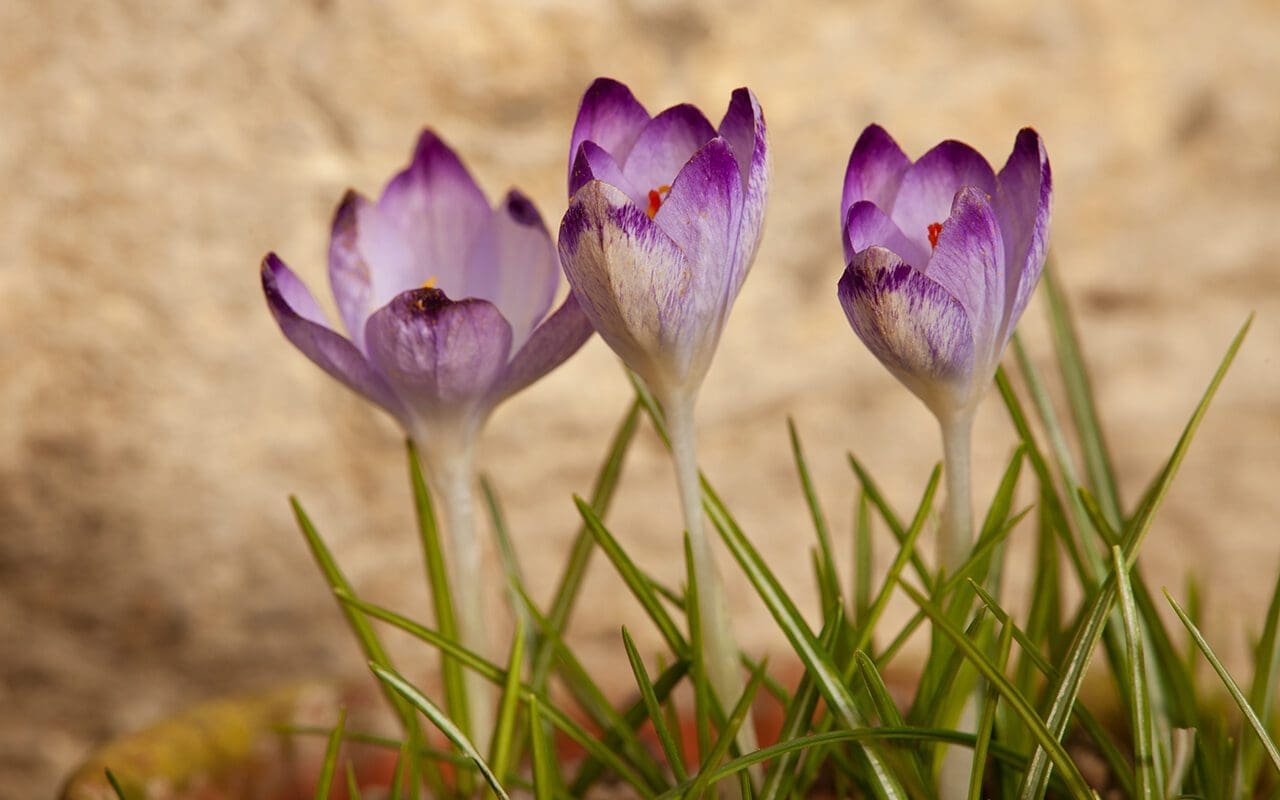
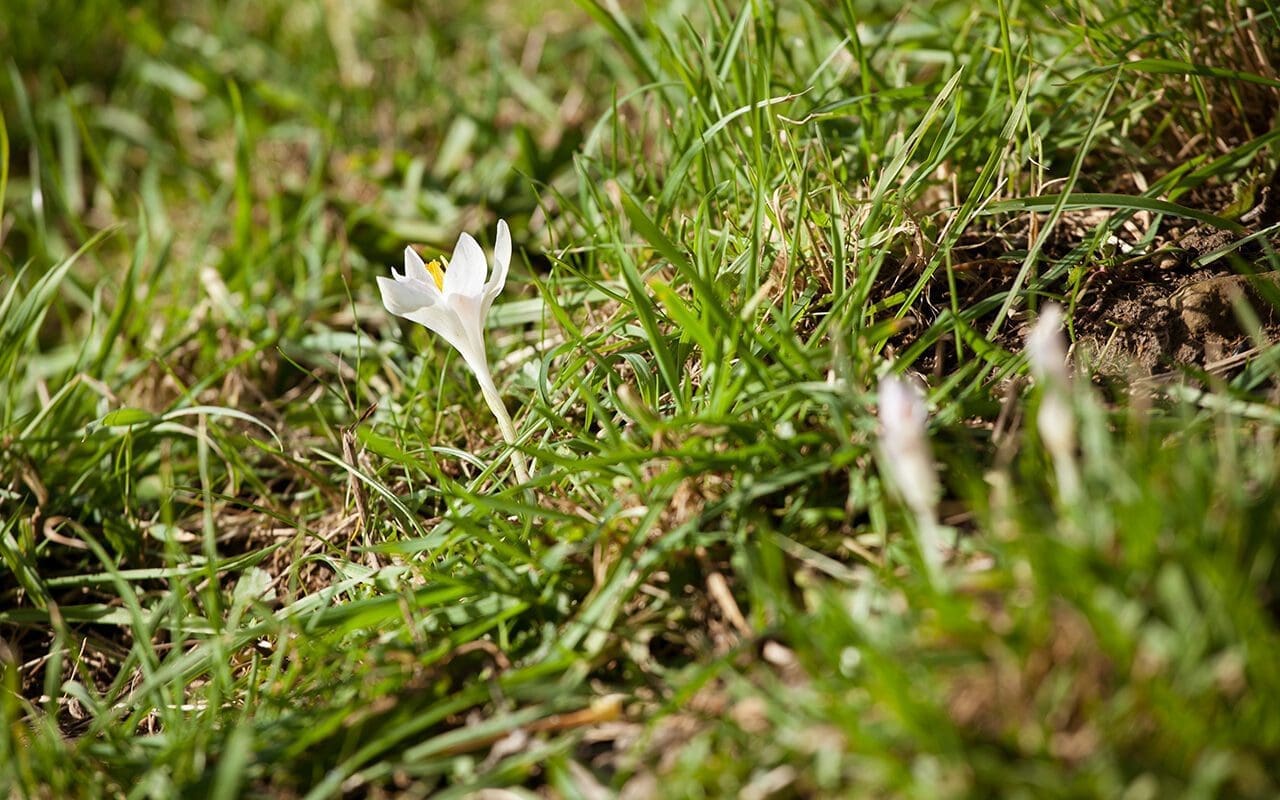
Words: Dan Pearson | Photographs: Huw Morgan
Published 20 February 2021
Life has begun to stir, the snowdrops suddenly visible and lighting the gloom. Over the last ten years I have been adding to a ribbon that is designed to draw us out into the landscape. It starts in the hedges close to the house and skips down the ditch in a stop-start rhythm where I have found the places that they like to be. Not too wet and with just enough shadow to keep the grass down once they have come into leaf and do their bulking. They reappear then down by the stream to run its length and ensure we walk our stretch whilst we can still get to the water in winter. The gesture demands generosity and commitment to adding to the trail, like a conversation you come back to, but is never really done.
We need to think expansively beyond the curtilage of the garden, where the land takes over and we could never nor want to control all that we see. Although the touch by necessity needs to be light in these wilder places, it should also feel generous. Not in a conspicuous way, but right because you have found a niche and then followed it. The big moves always start with a small one. Finding the place that a plant likes to be and understanding why and then going with it.
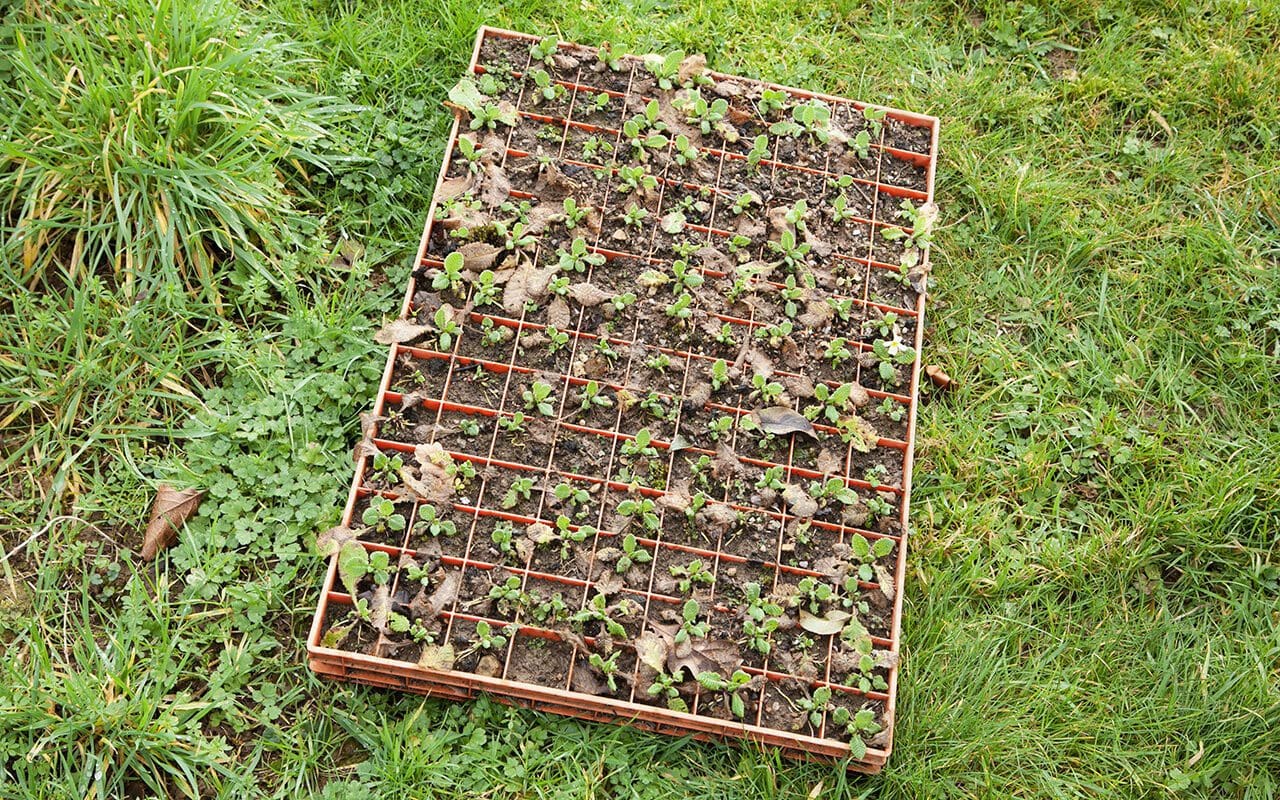
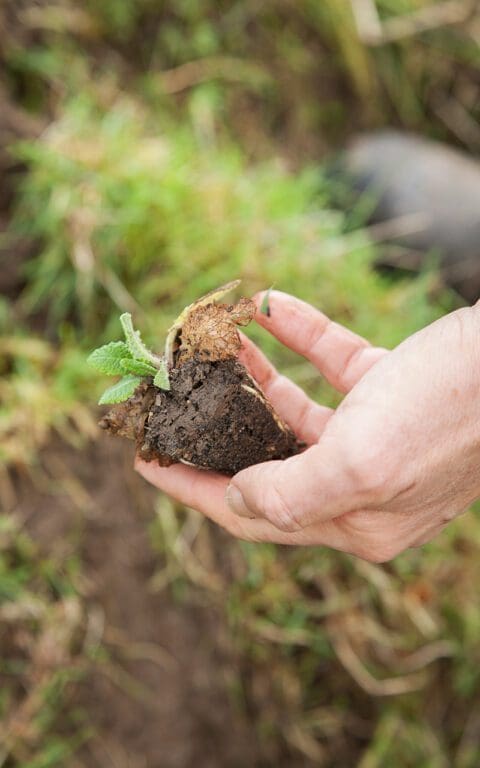
Working at scale in these wilder places demands both patience and persistence. Neither feel forced or hard won when the mother plants begin to seed. The primrose splits from five years ago came from a colony that was hiding amongst a cage of brambles. We fenced the ditch to keep out the livestock, cut away the brambles and the primroses proliferated on the hummocky slopes where each had its little microclimate. The splits – taken early in April not long after the primroses had peaked – were found a similar position and, where we hit the sweet spot, they are showing their happiness there in seedlings. The seedlings slowly erase your hand. The regular rhythm you try to avoid when planting, but cannot help but read when you look back on what you have done. The seedlings skip a beat, their seed taken to a new place by ants. The ones that come through feel right for having found their own place.
By its very nature my role as the ‘gardener’ of these natural processes cannot help but want for a little more. So where splits have proved to be too slow – the mother plants taking time to bulk – I have taken to collecting seed. This is ripe in June, but you have to watch carefully then as the plants are often consumed in the shadow of summer vegetation. The seed is best sown fresh or it begins to enter a period of dormancy that is hard to break. Fresh seed germinates erratically, some in the late summer and over autumn, but the majority in the spring after it has had time for the frost to do its work.
I sow three or four plug trays each year (between 300-400 plants) casting the seed over the tray and then top-dressing with sharp grit to protect it. Sowing annually means that I have a relay of seedlings on the go. Seedlings are left in the trays for 18 months and planted out just about now, when there is time for their early growth to get ahead of the competition. This year the seedlings are going into the steep banks up behind the house, where the sheep have opened up the ground with heavy grazing and poaching. The slope is south-facing and primroses love to bask in early sunshine. Here the bees find them early too. The summer cover of the grassland that rises up around them will keep them in the shade they like later.
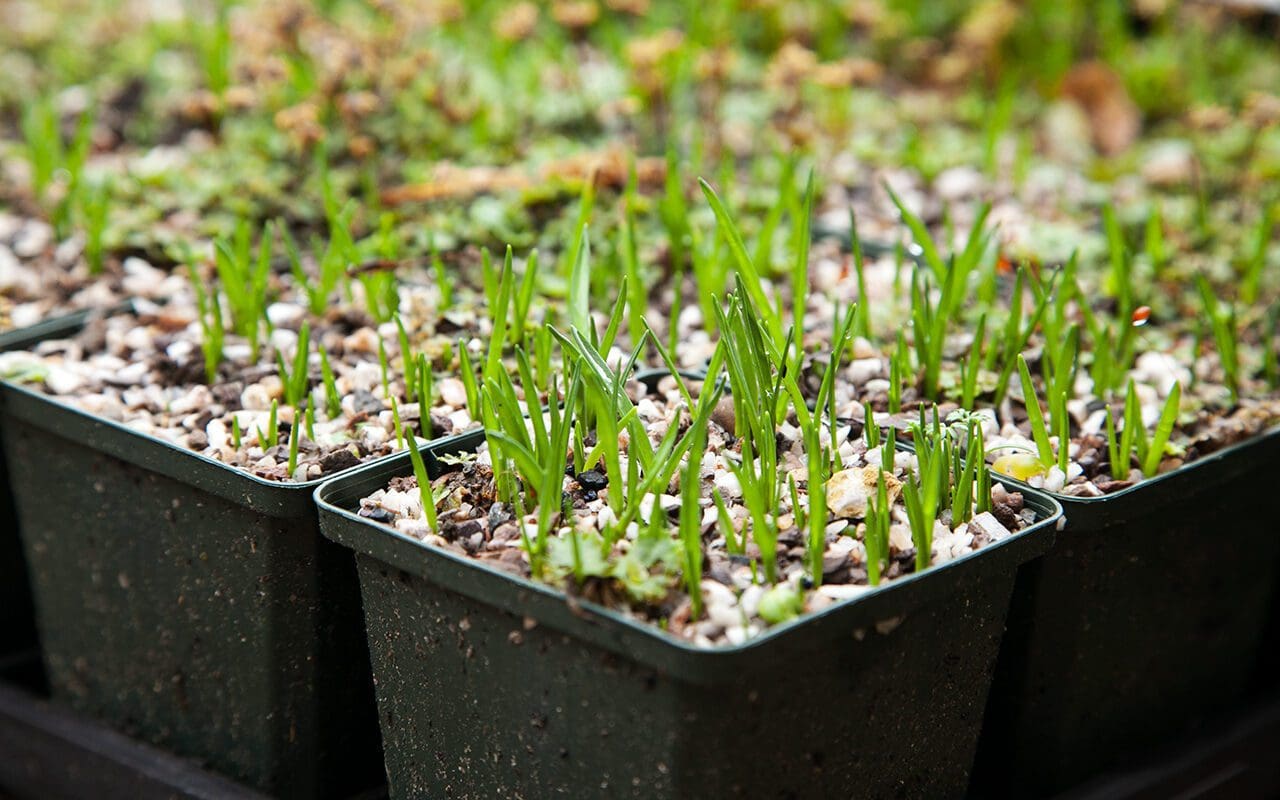
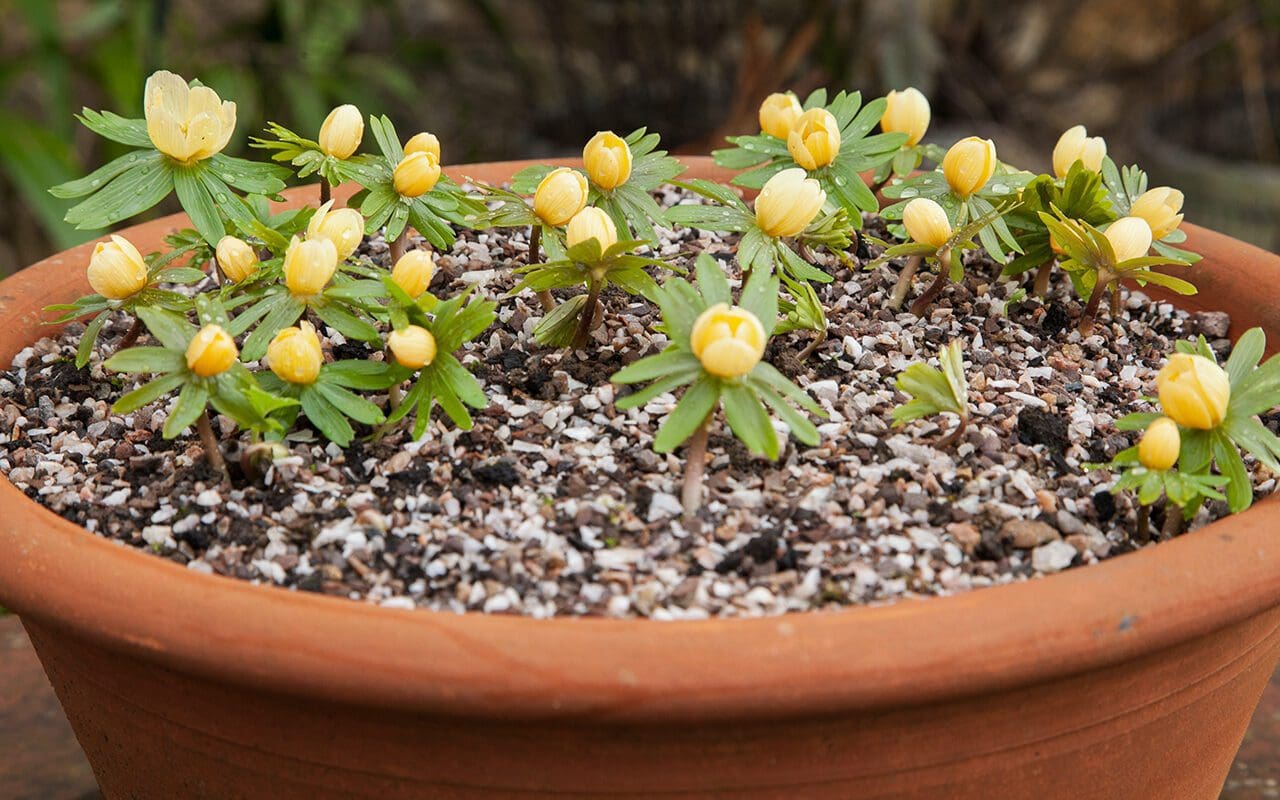
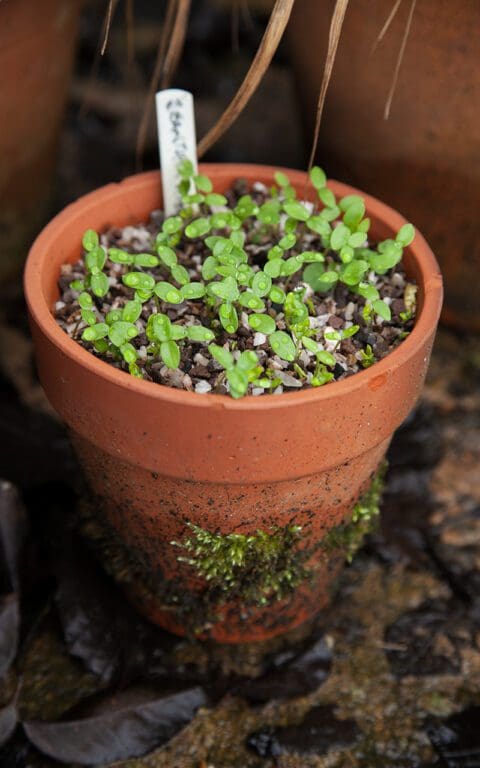
Also in mass production and destined for the wilder places are some locally sourced bluebells grown from seed. This is not bluebell country, their niche here being on the heaviest clay in the woods and not where it is too rich and competitive. I have been studying our ground to find the place where I imagine they might thrive, even just in pockets so that we have some pools of blue in the coppice.
Then there are the bulbs that are too expensive to buy in bulk and that I hanker for en masse. Camassia leichtlinii originally bought as ‘Amethyst Strain’ from Avon Bulbs and now renamed Avon Stellar Hybrids, are destined for the ditch. Well-named for their colour range of mauves and lavenders, their propensity to rampant seeding in the open ground of the garden will be mediated by the competition of grass. Tulipa sprengeri (at a prohibitive £5 a bulb) comes easily from seed if you are prepared to wait, as does the pale-flowered form of the native early winter aconite, Eranthis hyemalis ‘Schwefelglanz’. I plan for sheets of this butter-yellow form one day, in the places that are too damp for the snowdrops, but on the same trail and flowering with them in January. Though the wait is usually five years to flower for most of the bulbs, the beauty of sowing every year means that there is always a tray finishing the relay and ready to join the land of plenty.
Words: Dan Pearson | Photographs: Huw Morgan
Published 30 January 2021
The Iris unguicularis arrive at precisely the moment it becomes apparent that winter is here to stay. Spearing clear of their strappy foliage whilst the world around them is in retreat, the tightly rolled buds provide untold good feeling. Their intermittence is welcome, the flowers appearing in the mild weeks and not in the cold ones from now until February snowdrops.
Although I have never seen the Algerian iris growing in the wild, I hanker to do so. To follow them one day on a journey through Greece, on into Turkey and all the way through to Tunisia. It would be good to see exactly where they grow in these rocky landscapes and why the best advice in this country is to plant them at the base of a south-facing wall with their backs against the reflected heat and their foliage basking in sunshine. This was exactly how my great friend Geraldine grew them, close to but not in the shade of a twisted fig and with nerines that shared their need for a baking. This was a treasured spot in her garden and I remember her justifying their neglect as she pulled me up a piece one autumn, conjuring, as she did so, their homelands and intolerance of cosseting. No food, no water and certainly no shadow. They prefer, she said, to be growing in rubble.
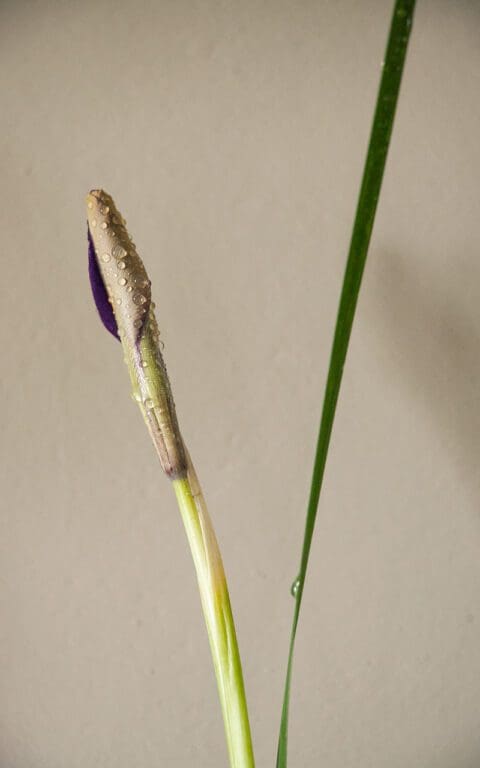
Although I have long since lost the original plant she gave me when I was a teenager, I can see them like yesterday on her kitchen table. Plucked in bud, to get the benefit of a long stalk and savoured expectation, they sat on their own in December and then, as the winter deepened, with witch hazel, pussy willow and wintersweet. The pale buds, with their picotee edging and tease of the sumptuous interiors, unroll in a matter of minutes once brought inside into the warmth. If you are lucky, you will witness the unfurling, but unless you make the time the transformation happens when you have your back turned.
Up close and inside in the warmth, their delicate perfume makes you wonder why they are happy to live with our wet and grey, scowling winters. In the wild, of course, where wet days are reliably followed by a week of bright sunshine, they are forage for bees when little else is blooming.

The plants I have here in Somerset came by way of a gift from the great nurseryman Olivier Filippi. I had been tasked by the National Trust to re-imagine the Delos garden at Sissinghurst and I had gone to see him in France to seek advice about the best plants for the job. The climate near Montpellier could not be more different from Kent, with low rainfall in the winter and months without it during a long summer. The garden alongside the nursery is remarkable and it was here that I came upon the Algerian iris providing their bright wintery flower under pines on the periphery of the garden. It was a surprise to see them out of my imagined context, not amongst rocks, but growing through pine needles so, where we augmented the soil at Sissinghurst with 50% grit, I have experimented with them in a range of conditions, including open shade.
My plants from Olivier are his own selections, a pale mauve-pink called ‘Bleu Clair’ and the much darker ‘Lucien’ which is the bud we plucked today. The old gold reverse gives the merest hint of the darkly rich flowers in the finely drawn edge to the reverse of the petals. More readily available here is a fine form called ‘Walter Butt’, which is truer to the species and the colour of a clear wintery sky. I have this plant at the London studio and plan to bring some here and find it a place nearby so I can enjoy them together.
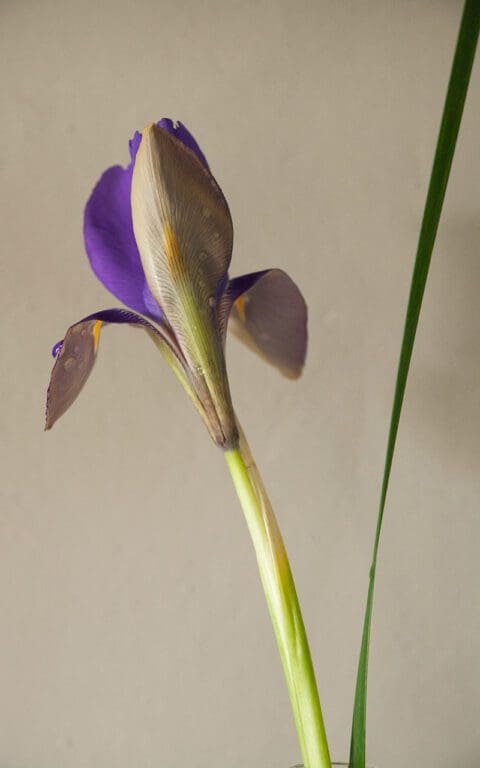
Here, on our hearty loam, I have not been tempted to grow them in anything but full sunshine for fear of our West country wet being their downfall. They are planted in a free-draining position, with plenty of air and paired only with plants that do not smother their growth in summer because their rhizomes need the opportunity to store energy for winter flower. Erigeron karvinskianus and violets make good company. I have also not been tempted to do as the books advise and cut their evergreen leaves in the autumn to reveal the flowers clear of their foliage. Although it is often described as tatty, I like the flowers sitting pure and wild amongst it.
So, here they are on the gravel drive to lighten our daily movements on this well-trodden path. When darkness descends and it is still the afternoon, these small things count.
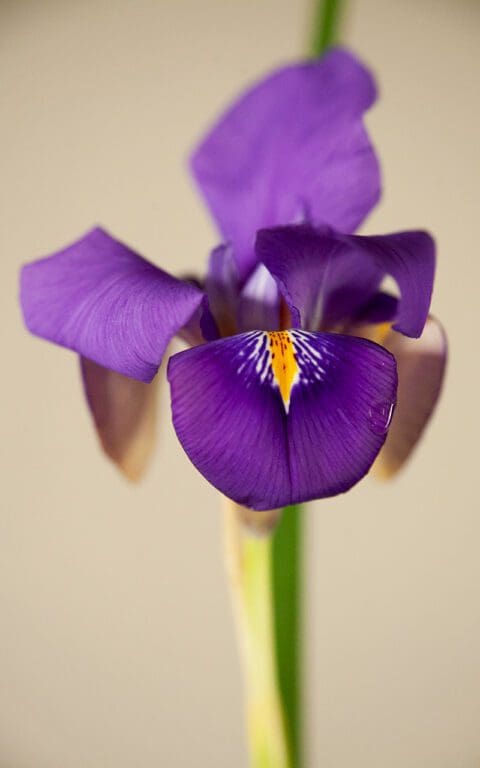
Words: Dan Pearson | Photographs: Huw Morgan
Published 12 December 2020
Every autumn, with late September sun on my back and the prospect of this very moment in mind, I spend an afternoon potting up the winter-flowering iris. A winter without them would be a winter without this particular prospect. A spear of optimism that pushes life regardless, into the dark months.
Here I save my hottest, driest spots for autumn-flowering Galanthus reginae-olgae, Amaryllis belladonna, Sternbergia lutea and the perennial, strappy-leaved Algerian Iris and so keep to the habit of growing the bulbous winter iris in pots. We are now spoiled for choice as there are so many named forms. The earliest to flower is Iris histriodes, which is distinct for having slightly shorter growth and wider flowers than Iris reticulata. There are also crosses between them and the yellow-flowered Iris winogradowii. Of them all I prefer the elegance of the Iris reticulata, which draw a more finely-penned line, but they are all worth exploring and every year we trial two or three new varieties and return to a favourite or two to reacquaint ourselves.
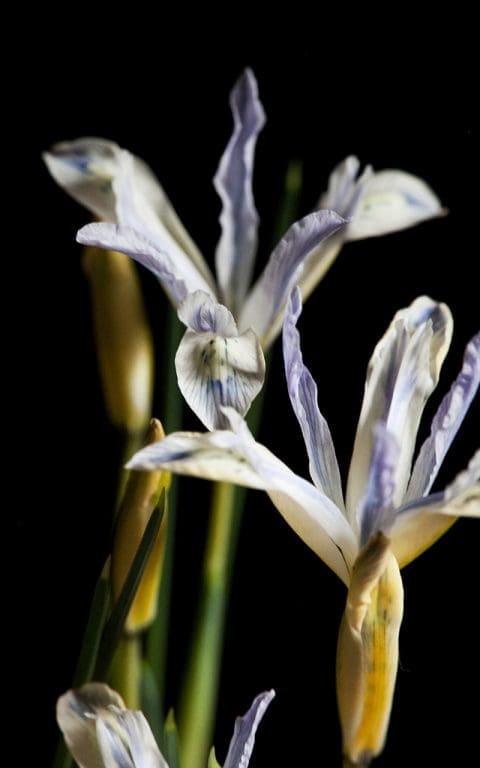
I have learned over the years that growing them in pots is the best way to grow them here. Hailing from Turkey, where they have a summer bake ahead of them, they make the most of the winter rains and the short and furious growing season. A winter which is all about readying for spring and where rest is not an option. They bring all of that energy with them and are more than happy to do their best in our benign climate in Britain, but our summer is their downfall. Like tulips, they need the bake and the dry come the summer and you have to find them a free-draining site which emulates their homeland if you are to be successful in keeping them long-term in open ground. The damp of the West Country, in combination with our heavy soil, means that I have the tiniest slivers of such ground at the base of south-facing walls that would see them doing well. This is not to say that it is not worth trying, but if you do have the right position, plant them deep at 15 to 20cm so that they are below the runs of mice and voles.
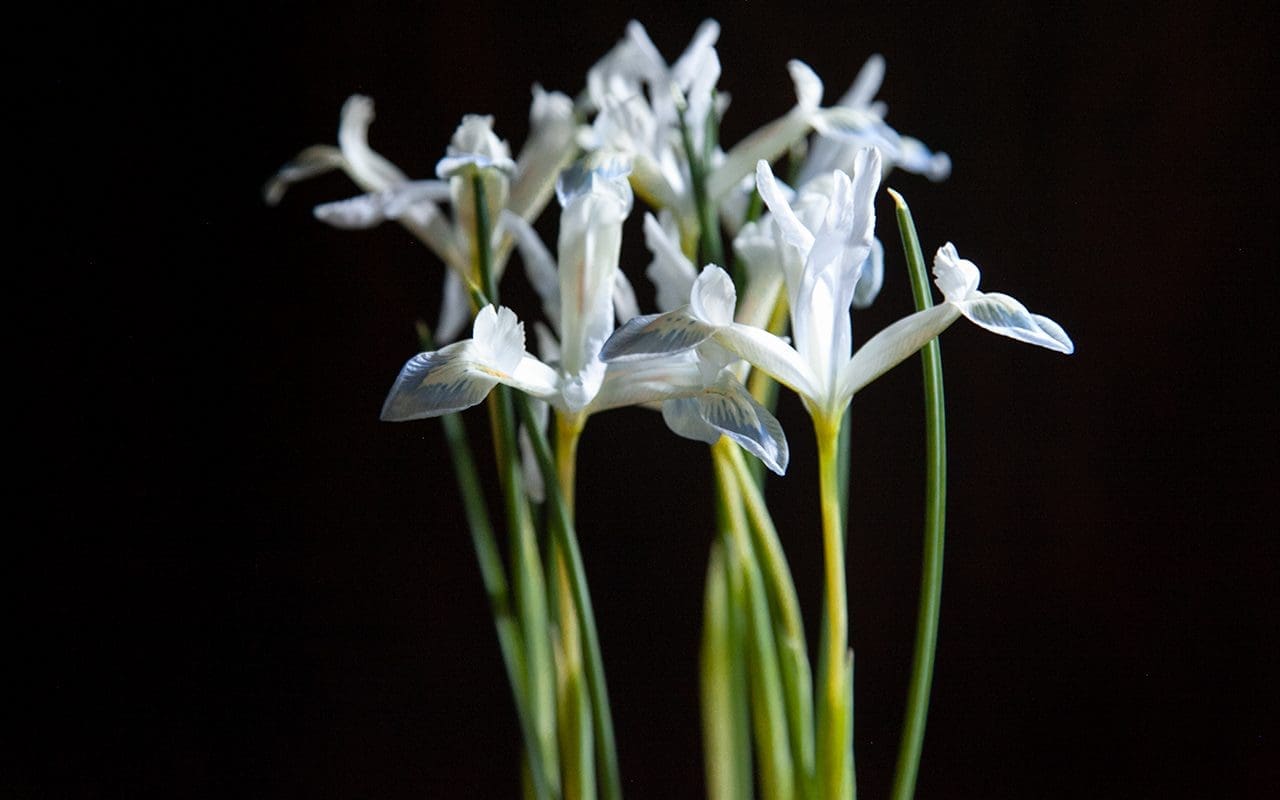
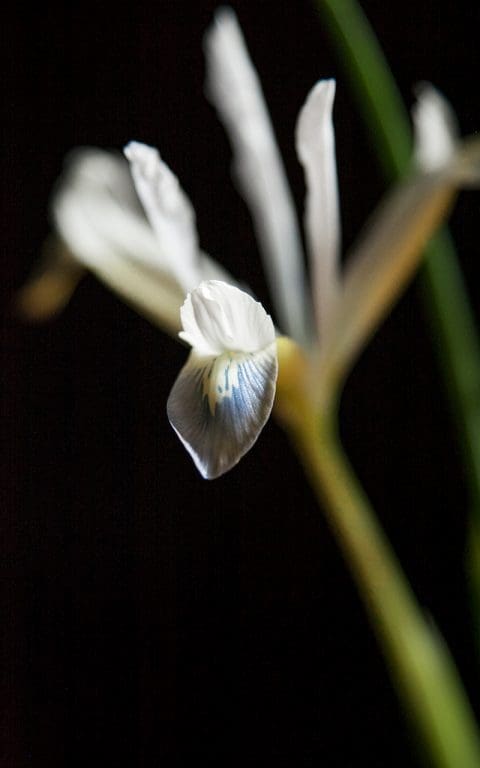
The bulbs are small and you need no more than five to a pot. Any more, or plant them too densely, and the elegance of the flowers is lost in the crowd. The bulbs are planted deep in the pot and put in the frame to keep them on the dry side and with just that little bit of extra protection to steal a week or perhaps a couple on the winter. The first spears of foliage were visible at new year this year. These early signs draw you back regularly to check on the shift which takes place rapidly as soon as you see the papery, translucent sheath that protects the flower buds. If you wait until this moment and bring them into a cool room in the house, the pointed buds will rise fast and silently in a day. If you are prepared to cheat again and bring them into slightly more warmth you can witness the petals unfurling like a Chinese fortune fish that curls in your hand.
Inside the flowers last for no more than a weekend, but you do get to witness them up close and intimately as I am doing now as they sit in front of me on my desk. Then you will also be able to take in their fine but certain perfume, like a cross between primroses and distant violets. This year, the tallest of the three that have come together this weekend is ‘Painted Lady’ (main image), the first to flower. Yellow, speckled buds open palest lavender, the blue leopard spots staining the tips of the petals as if they were bleeding. Next to flower was ‘Frozen Planet’, again pale but well-named for the ice-blue cast that intensifies to colour the whole of the falls. Last of the three is ‘Fabiola’, a substitute made by the nursery. Although my “no substitutes” rule is usually hard and fast, I am pleased to have this one. It is always good to have a dark form in the group, so as to have the gold flare in the throat set off by rich royal purple velvety falls.
We love them all, but I do not have the heart to keep them inside for long, since they last a fortnight outside in the shelter of the house and we return to them daily to enjoy their every moment.
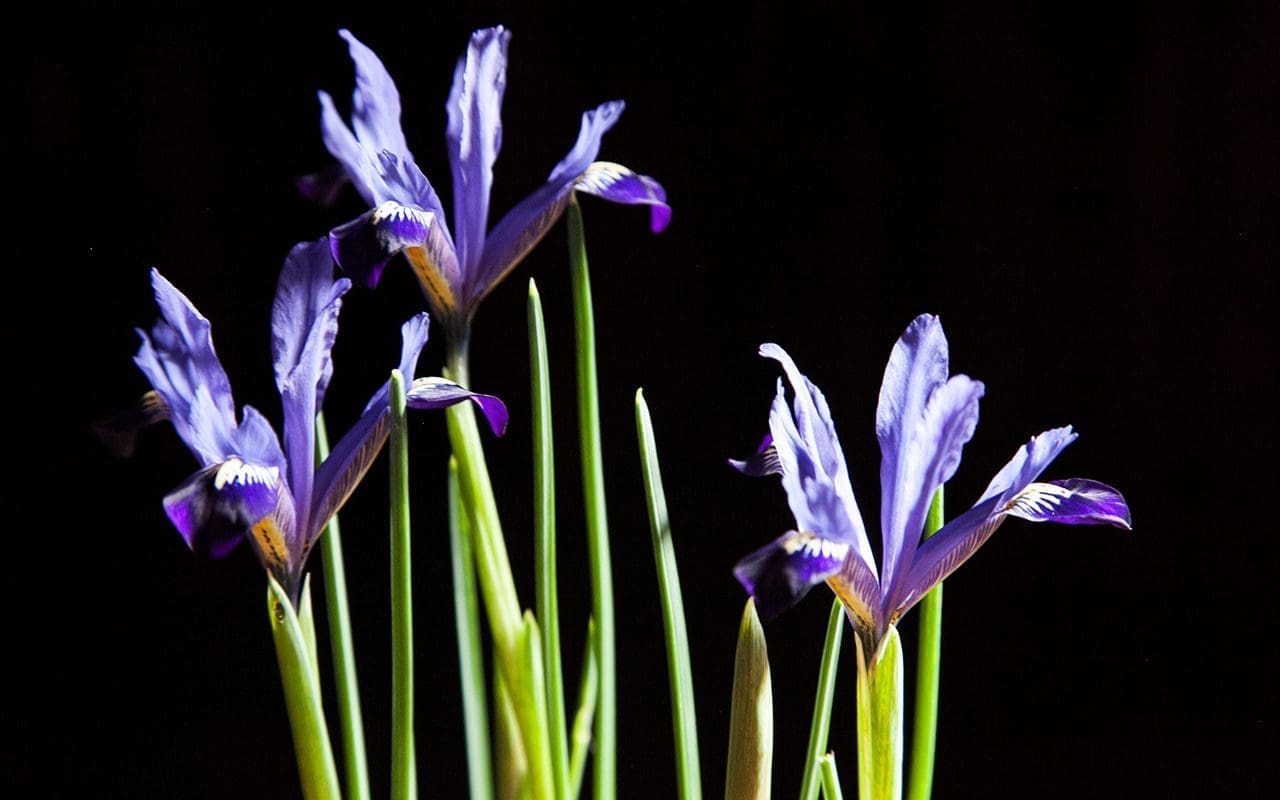
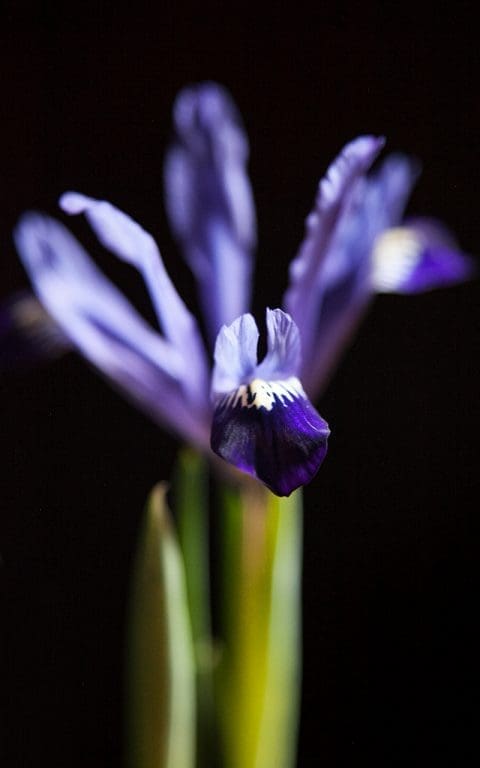
Words: Dan Pearson | Photographs: Huw Morgan
Published 1 February 2020
The autumn crocus appear late with the last of the asters and braving the change in the weather. Although I have only just planted the real saffron crocus, Crocus sativus, and wait to see whether it can handle our moist Somerset loam, I can now say squarely that I can depend upon Crocus speciosus, which are beginning to naturalise on the bulb bank behind the house. This year they came in the first two weeks of October during a fortnight of rain and heavy skies that accelerated the feeling of the evenings drawing in, but their appearance completely runs against the retreating tide and the feeling that goes with it.
Triggered by the very cool and the damp in the ground that puts an end to the growing season, they score the palest lilac tapers into the grassy banks. The true colour of the interior is suggested, but held back on the reverse when the buds are closed, but opened by sunshine or the warmth of a room if you pick one, they flare a bright lilac. Look inside and the violet tracery of dark veins maps an upward movement, the orange styles, luminous and hovering in a pool of colour. Look deeper and the dip of a yellow throat appears to throw light from this inner world.
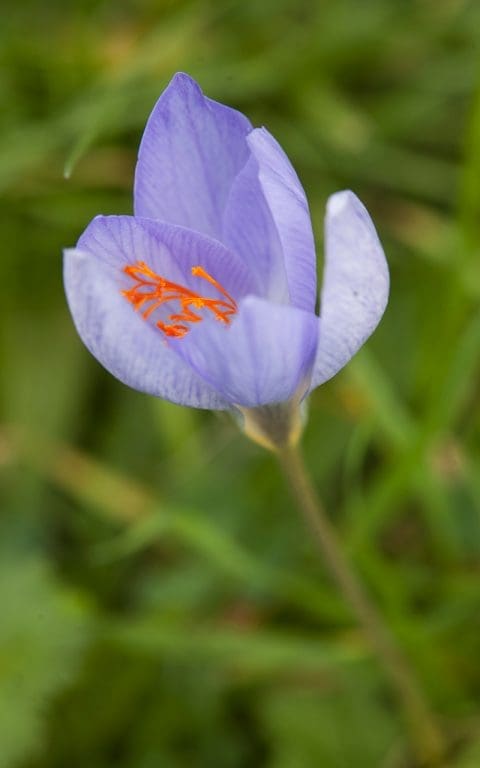
Seen from the kitchen that is dug into the hill at the back of the house, the crocus appear just above eye level where I have planted them in an extensive drift. Standing tall at around 20cm, the stems push the flowers free of the meadow, which was cut late in August to make way for their arrival. The stems are impossibly delicate and, grown in an open position, they will easily break, not completely, but enough to topple the flower so that it lies fallen by those that have yet to do so. Planted in grass, which by October is grown just enough to support them, the majority stay standing and you can rely upon their display. A gentle autumn is what they enjoy most of course, but their emergence is always late enough to catch the turn in the weather.
Native to Greece, northern Turkey and Iran, the hot dry summers put the bulbs into ensured dormancy and a wet autumn triggers growth. Here they are best in a position that emulates their homeland and dries in the summer months and hydrates again in the winter when their foliage comes above ground to feed. A position under deciduous trees, where light comes to earth in the winter and the rootiness of ground dries in summer is ideal. Turf or meadow that remains uncut until their foliage withers in spring will also protects them during dormancy. If you are introducing the bulbs into turf, do so early in the bulb planting season to allow for their rise to October flower. Planting deep, up to 12cm, will also help keep them out of reach of mice, which are a favourite predator.
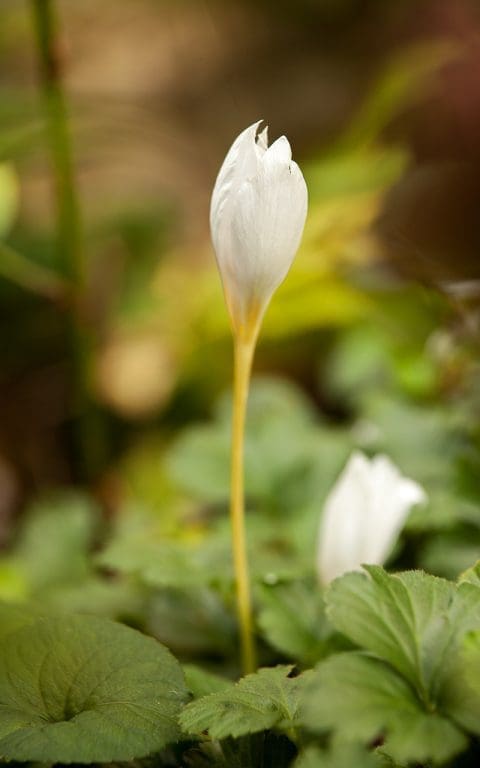
In the garden proper, I have been slowly introducing the white form, Crocus speciosus ‘Albus’, in areas that are sheltered from wind. In the lea of the barn where the low ground cover of violets and Waldsteinia ternata protect winter cyclamen, I have found them a niche. The white form is more ethereal still than the true species. Simpler for being white inside and out, but still with the charge of the orange style and the yellow throat, they are worth devoting a corner to for late season contemplation. Their grassy foliage with its silvery midrib comes in early winter and makes a pretty addition and complement to the marbling of the cyclamen leaves. Something to look forward to and to rely upon as the days shorten.
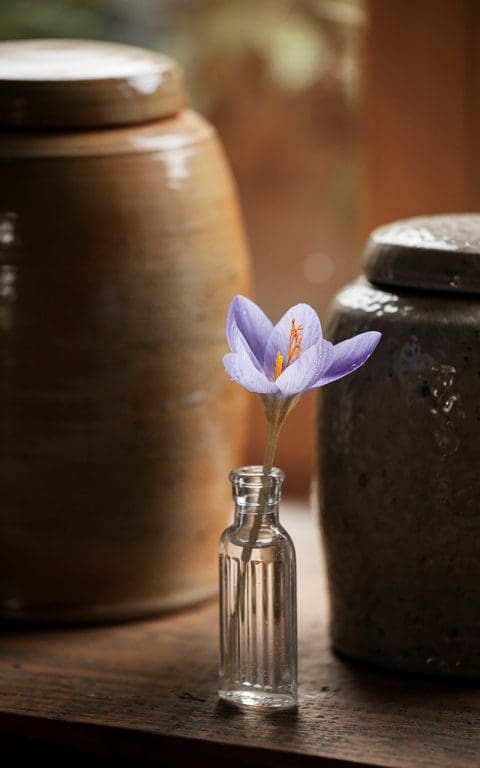
Words: Dan Pearson | Photographs: Huw Morgan
Published 26 October 2019
It has been a long, slow start to spring, but at last we have movement. The snakeshead fritillaries are chequering the slopes behind the house and crossing over with early daffodils that this year were a whole two weeks late. The long wait will now see a rush as everything comes together, but reflecting the last few weeks of slim pickings we have kept things simple in this April gathering.
The wet weather has hit hard this year and Tulip Fire has run rampant through the tulip bed. We mass the tulips together in a random mix of six or seven varieties in the kitchen garden and experiment with a new colour palette and untried varieties every year. This year we planned for soft reds, pinks, oranges and apricots with an undercurrent of deep purples. However, we did not plan for the angst that has come with the mistake of replanting too soon in the same place. The Tulip Fire (Botrytis tulipae) probably came in with the bulbs that were grown in the same bed two years ago. A dry spring that year most likely limited its impact and it went unseen. This wouldn’t have been a problem if we’d not replanted in the same place for three to five years.
We will not be making the mistake again, for the majority of this year’s flowers are withered, pock-marked and streaked, the foliage melted on the worst affected. As soon as the flowers that are harvestable have been cut, we will dig up the bulbs and burn them on the bonfire. It has been a hard lesson after a long winter and one never to be forgotten, but we have managed to salvage enough to appreciate close up.
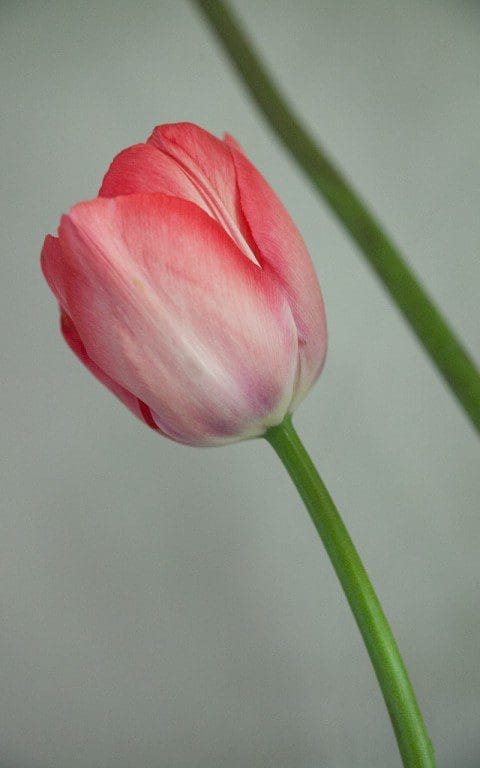 Tulipa ‘Van Eijk’
Tulipa ‘Van Eijk’
We will be trying Tulipa ‘Van Eijk’ again, for its faded pink exterior which conceals the surprise of a bright scarlet interior. The flowers enlarge and age gracefully, first to a strong lipstick pink before ending up a washed rose with the texture and shine of taffeta. It is said to be a variety that comes back for several years without the need for lifting, so next year I will try it by itself in some fresh ground. Planting in late November or early December when the weather is colder is said to diminish the impact of the botrytis should it already be in the ground. Grown on their own and not in the mass of different varieties, they may stand a better chance of staying clean. We have now kept a note to move our cutting tulips between beds on a five year rotation.
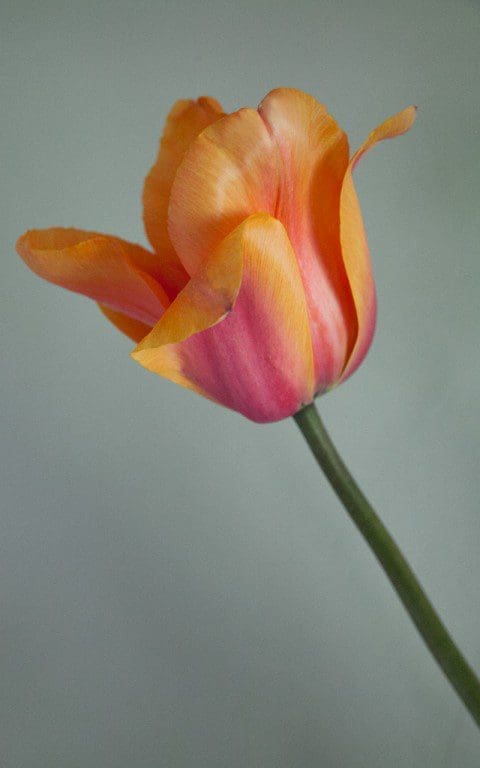 Tulipa ‘Apricot Impression’
Tulipa ‘Apricot Impression’
Tulips are remarkable for their ability to grow and adjust in a vase. The long-stemmed, large-flowered varieties exaggerate the quiet choreography that sees their initial placement becoming something entirely different as the flowers arc and sway. The complexity of colours in Tulipa ‘Apricot Impression’ is promising. The raspberry pink blush in the centre of each petal is quite marked to start with, but suffuses them as the flowers age creating an overall impression of strong coral pink bleeding out to true apricot. The insides are an intense, lacquered orange with large black blotches at the base and provide voluptuous drama as they splay open with abandon. Though our choice of tulips has been somewhat pared back this year, it is good to have enough to get a taste of the selections we’d planned.
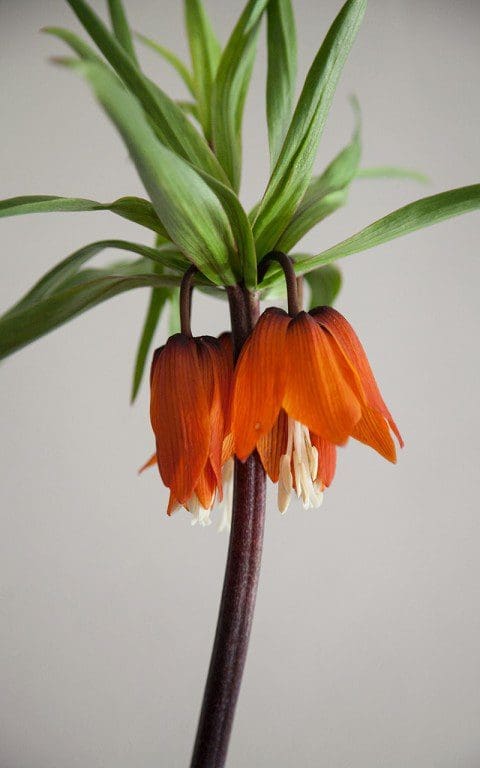 Fritillaria imperialis ‘Rubra’
Fritillaria imperialis ‘Rubra’
This is the first time I have grown the Crown Imperial (Fritillaria imperialis) here, and their story has been entirely different. Up early, the reptilian buds spearing the soil in March, and quickly rearing above the dormant world around them, their glossy presence has been so very welcome. I have drifted them in number on the steep slopes at the entrance of the new garden amongst the rangy Paeonia delavayi. Fritillaria imperialis ‘Rubra’ has strong colouring with dark, bronze stems and rust orange flowers that work well with the emerging copper-flushed foliage of the peonies. Although there is an exotic air to the combination, it somehow works here up close to the buildings. It is a combination that you might imagine coming together through the Silk Route, China and the Middle East. However, plant hunters had already introduced the fritillaria from Persia in the mid 1500’s, and so it also has a presence that speaks of a particular kind of old English garden.
At the opening of the Cedric Morris exhibition at The Garden Museum this week Crown Imperials were a key component of Shane Connolly’s floral arrangements, scenting the nave with their appealingly foxy perfume. The smell is said to keep rodents and moles at bay and, though potent, is not unpleasant in my opinion. Morris’ painting Easter Bouquet (1934) captured them exuberantly in an arrangement from his garden at Benton End, which updates the still lives of the Dutch Masters with muscularity and vibrant colour. Rich, evocative and full of vigour, the paintings confirmed to me why we push against the odds to garden.
I planted half the bulbs on their side to see if it is true that they are less likely to rot, and the other half facing up. However, contrary to advice the two failures were bulbs planted on their sides. I also planted deep to encourage re-flowering in future years. The bulbs are as big as large onions, but it is worth planting them at three times their depth since they are prone to coming up blind when planted shallowly. In their homeland in the Middle East, they can be seen in the dry valleys in their thousands after the winter rains, so I am hoping that our hot, dry slopes here suit them. They are teamed with a late molinia and asters, to cover for the gap they will leave when they go into summer dormancy.
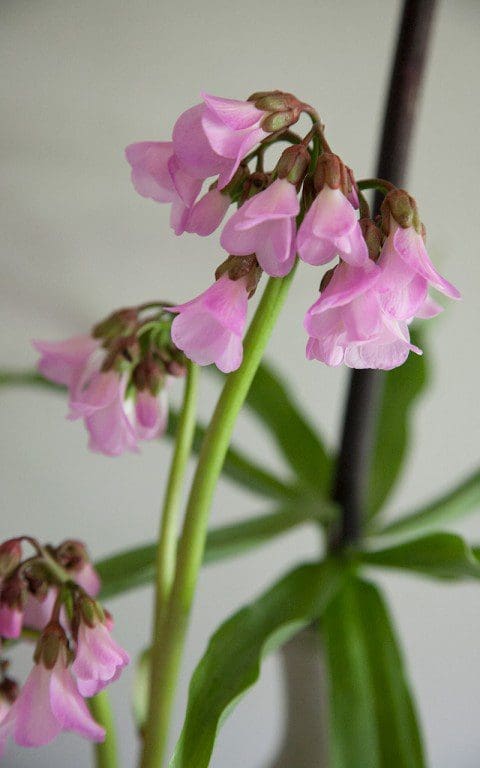 Bergenia emeiensis hybrid
Bergenia emeiensis hybrid
The third component in this collection is a pink hybrid form of Bergenia emeinsis. It was given to me by Fergus Garret, who tells me it was handed down by the great nursery woman Elizabeth Strangman with the words that it was a “good plant”. Sure enough, despite its reputation for not being reliably hardy, it has done well for me and flowered prolifically for the first time this year amongst dark leaved Ranunculus ficaria ‘Brazen Hussy’. However, the combination was far from right, the sugary pink of the bergenia clashing unashamedly with the chrome yellow celandines. A combination Christopher Lloyd may well have admired, but not one that feels right here.
However, the elegant flowers are held on tall stems and the leaves are small and neat, so it has been found a new home in the shade at the studio garden in London, where it can be eye-catching when in season against a simple green backdrop. Though this recently introduced species from China grows in moist crevices in Sichuan, it is happy to adapt and is so prolific in flower that I had to find it a place where its early showiness feels right, rather than getting rid of a good plant. More lessons learned, and more to come now that the tide has finally turned.
Words: Dan Pearson / Photographs: Huw Morgan
Published 21 April 2018
It has rained every day but one over the last fortnight. Not just a passing shower, but the whole day, like the ones you remember confining you to the house during the school holidays. The ground is wet, as saturated as it can be, and the stream has been rushing driftwood into dams, scouring the banks and rumbling stones into new places.
I have ventured carefully onto the beds just twice whilst we have been here over the Easter period to pull bittercress and winter-growing speedwells. They have seized the no-go zone and have made growth despite the cold. Hardy celandines have flushed the hedgerows with leaf, but they have not been showing their lacquered petals because the sun has stayed behind cloud. Elsewhere, there is half as much growth as this time last year and I find myself yearning for the chance to fill a jug with spring things, for the excitement of the new.
With the winter refusing to loosen its grip, the pickings have been slim, but this is compounded by the fact that this is a new garden. The tardy spring is a also a clear reminder that when you start from scratch, a garden is a commitment to waiting and though I know it will ease as soon as the weather warms, right now I am feeling the hunger.
I have started a list of early to bloom flowers that I’d like to see more of next year. The garden could take more pulmonarias in several places and in quantity for that early colour, and so that I can lace them with early bulbs. Right now, this is a garden without bulbs, because I like to feel settled for at least a year before introducing a layer that can complicate change if you need to make it early on. We have bulbs in the meadow banks that are slowly establishing, but their absence amongst the new life of the garden is stark. I want to see erythroniums where there will be a little shade, Ipheion where the sun can spring open their flowers and early Corydalis to make their way through the groundcovers as they mesh together.
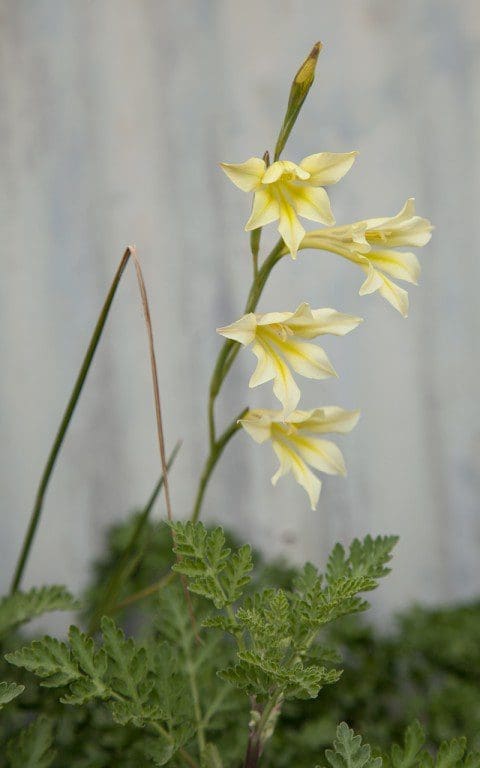 Gladiolus tristis
Gladiolus tristis
Up by the house and alongside the barn where we are a couple of years ahead and have already started to introduce the bulb layer, I have planted Crocus speciosus, Nerine bowdenii and Amaryllis belladonna for the autumn, but right now and rising above them all at the other end of winter is Gladiolus tristis. This willowy South African is a week or so later this year, but miraculous enough in its emerging form to stave off my hunger. Awakening from summer dormancy in the autumn, their needle like leaves push through the receding growth of their neighbours to stand tall already through the dark months. Reading will tell you that they need a sheltered spot and yes, I have seen this winter green foliage damaged in a frost pocket, but they have stood unscathed by this year’s winter on our exposed slopes. Literature will also tell you that the Marsh Afrikaner is to be found in wetland areas and on banks above streams in high grassland in the wild, but here free-draining ground and full sun provide their favoured position.
The flowers, which unfold themselves like bony fingers from their slender glove of foliage, are delicately balanced on almost invisible stems. Their necks tilt upward to suspend the flowers as they develop and there is room between each, flushing later in April first green then a luminous primrose to cream as they age. Standing at almost three feet by this point the hooded blooms will catch the slightest breeze to sway, tall and elegantly. At Great Dixter, where I first saw it in the Sunk Garden, I imagine its night perfume would be caught on still air held by the surrounding buildings. Here on our breezy slopes, we have it by the path so that you can dip your nose to the flowers at twilight.
Staking the rangy limbs is necessary if they strain and topple for light, so I like to grow it hard in a bright, airy place to keep strength in the limbs. Staking it once it is grown is almost impossible, however, as its foliage is every bit as delicate as the reeds it resembles and will bend irreparably once it falters. A network of hazel twigs, inserted if you can remember in the autumn, will allow it to grow into position and not to distract from its finely drawn outline. One that in every move of its early awakening will help in staving off the hunger pains brought on by a reluctant spring.
Words: Dan Pearson / Photographs: Huw Morgan
Published 7 April 2018
This first week in the month has brought with it change. The tip in the season is mapped in the scoring of luminous hazel catkins, their streamers hatching verticals into the backdrop of dark wood and hedgerow. These catkins are one of my favourite moments, catching the push of the cold easterlies and the sun when it breaks through the grey. And at their feet, pushing up leaf mould, the snowdrops have made their claim on the shortest month.
Despite the evidence that the grip of winter is loosening, I am always happy to have planned for more. Be it a small effort in the fullness of the previous autumn, a few pots of Iris reticulata are an essential. Just a handful of bulbs is all that is needed to bridge the need for new life and the trickle of spring which, by the time the iris are over, will be sure to be moving and constant.
Hailing from the Middle East, where they bask in winter sunshine when they are in leaf and bake whilst dormant in summer, they are difficult to keep here in the damp of Britain. That said, the bulbs are cheap and easy if you are open to the fact that they are fugitive, so the act of throwing the bulbs after they are over is less guilt-inducing. Plant them deep, to the depth of a trowel in free draining ground and you may have success, but on our hearty soil here they make nothing but leaf in the second year. I prefer the surety of an annual order and the promise they bring to the kitchen table.
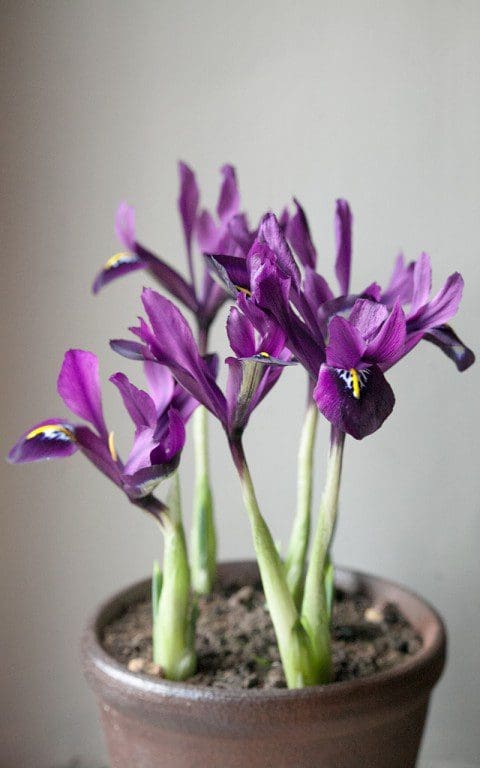
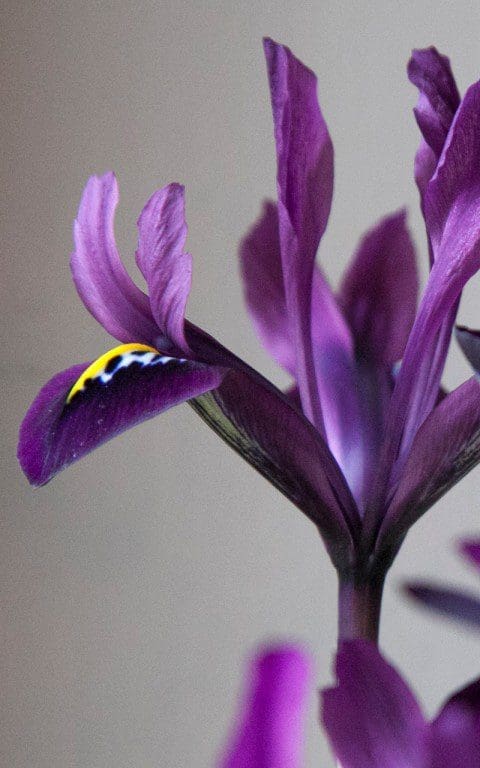 Iris histrioides ‘George’
Iris histrioides ‘George’
I’ve learned over the years that, if you are growing them for display, less is definitely more and that three to five bulbs is enough in a six inch pot. Plant any more and the flowers collide and become confused. The greater part of their charm is in their exquisite outline, slim as pencils when in bud and then pure and finely drawn in their asymmetry once in flower.
Potted in a free-draining compost and kept in a protected place such as the closeness of a house wall or a frame, they need little attention in the first half of winter. Come January, you will see that the spears of foliage have already broken the compost and, towards the end of the month, the tissue-paper sheath reveals the presence of buds held tightly in the base of the leaves. When you see the colour of the buds through the sheath, it is time to bring them in to a cool room to force the flowers and steal a march on the season.
In the warmth, the bud pushes free of its papery protection and rises a little, like a champagne flute on a pale, fine stem so that you can see the full outline. This happens fast when they are ready, over a day or two days at most and, if you are patient, you might witness the flowers open. One fall first, the next and then the third, jerking quietly out and then down to reveal the inner markings. These are exquisite, and variable in the many named varieties, some spotted and flecked, others pure colour broken only by a flame in the throat and the pollen of stamens. Inside, in the still and warmth of a room, you will also catch their delicate perfume. As welcome and as soft as that of primroses and easily lost outside in the blow of an easterly.
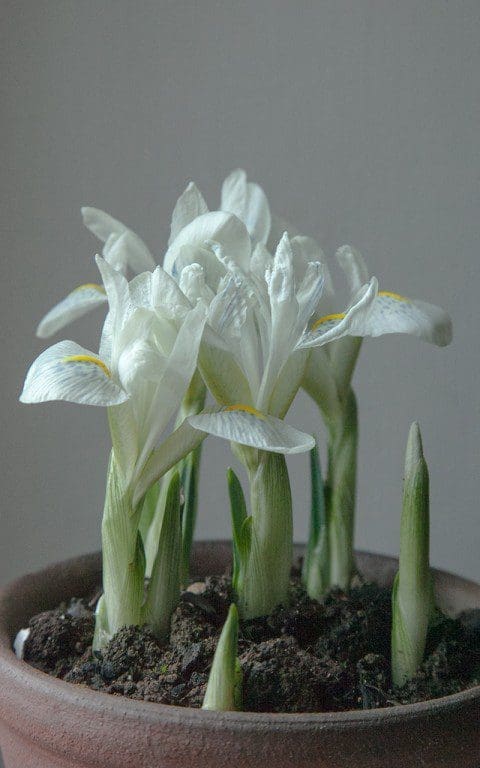
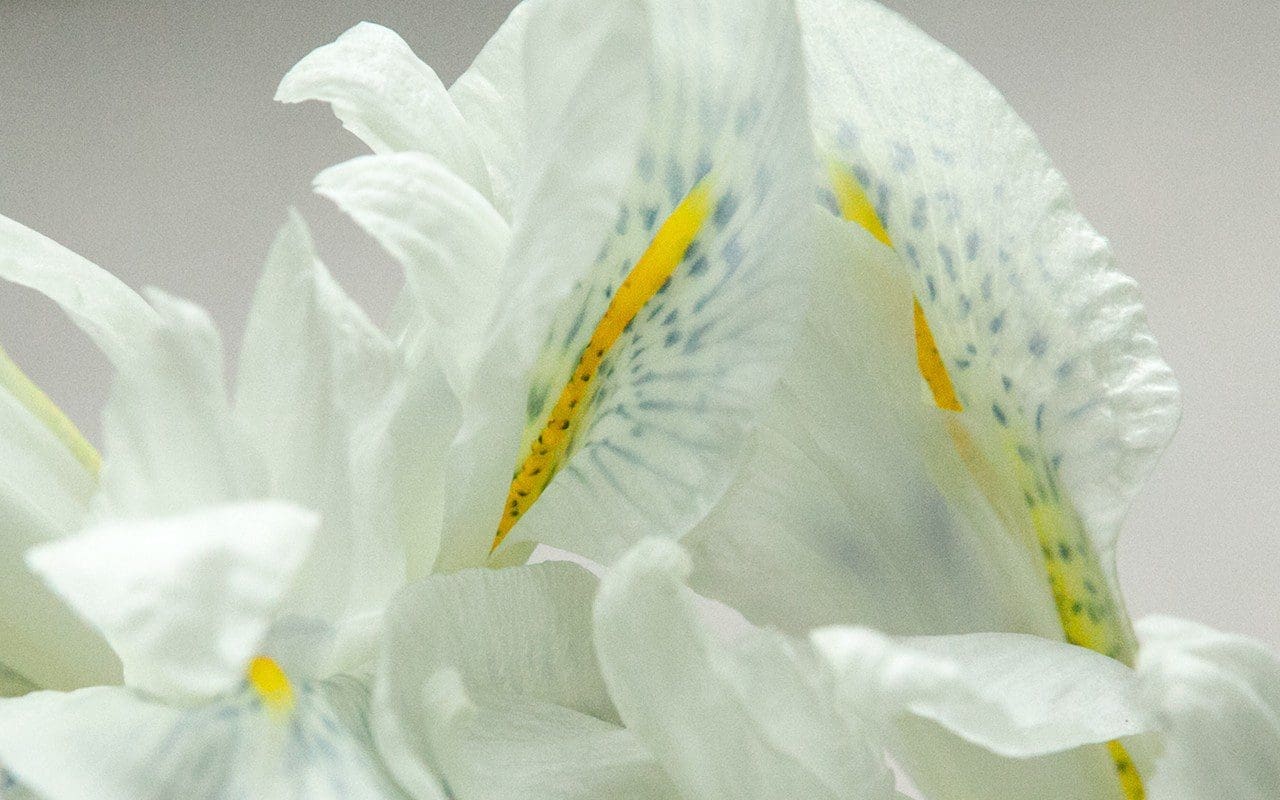 Iris histrioides ‘Finola’
Iris histrioides ‘Finola’
Every year we experiment with a new variety or two, buying ten bulbs of each and three or four varieties at most. We have found our favourites over the years. The slim, dark elegance of ‘J S Dijt’ is one that I would grow every year, and I generally prefer the rich plums of ‘George’ and ‘Pauline’ to the royal and denim blues of ‘Edward’, ‘Gordon’ and ‘Cantab’. However, we loved ‘Blue Note’ last year, with its narrow petals of deepest midnight and ‘Harmony’ (main image) is the quintessential blue spring iris of Japanese woodcuts.
I also have an enduring fondness for the curiosity of ‘Katherine Hodgkin’ with her washed-out, pale blue flowers with greenish veining and yellow leopard spots. Though we do not have it this year, the ghostly mother-of-pearl whiteness of ‘Finola’ is a recent find that I would like to revisit. It is always worth growing something new as there are many to choose from and a wealth of potential future favourites if you see each year as an opportunity for discovery. I already have the clear, sherbet-yellow ‘Katherine’s Gold’ and palest blue ‘Polar Ice’ picked out for next year.
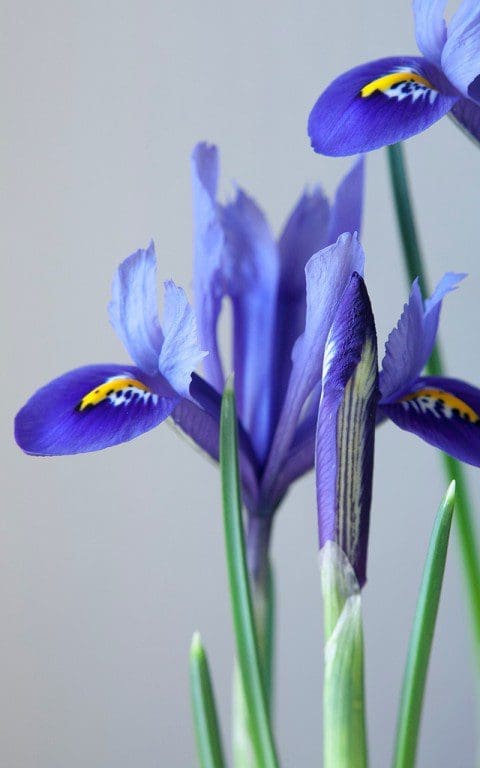 Iris reticulata ‘Harmony’
Iris reticulata ‘Harmony’
As you perfect the art of knowing when to bring them in, you can relay your pots for succession. Though the flowers last just a few days inside, if you have a half dozen pots and keep half in a shadier spot than the others, you will have flower for a fortnight to three weeks. Time enough to bridge the seasons.
Words: Dan Pearson / Photographs: Huw Morgan
Published 3 February 2018
We are sorry but the page you are looking for does not exist. You could return to the homepage